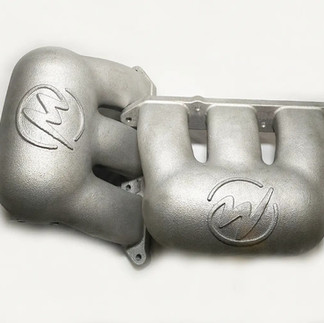
The past 12-24 months have seen an explosion in the popularity of the already coveted Toyota #gryaris hot-hatch with a host of aftermarket support being developed and offered for the G16E-GTS platform. And with the impending release of the GR Corolla, there's no stopping the bandwagon now.
The GR Yaris has aesthetic appeal, racing homologation pedigree, and together with the performance & "mod-ability" of the #g16egts platform, the GR Yaris is not the hero we deserve, but it's the hero we definitely need.
So the floodgates opened! For better or worse the GR Yaris modification rush had begun.
**Violin begins to play** But when we first got our hands on one, it was obvious that the OEM Intake Manifold design left a lot to be desired in regard to maximising the performance from the platform.

So we got to work...Measure, CAD & CFD design, 3D print, test fit & repeat ad infinitum. Well maybe not to infinity, but 12 months later we had a final prototype (pictured below) which was our own clean-slate design, maximised the available space, was a direct bolt-in fitment and showed measurable power & torque increases.
And yet, as I type I can hear the death cries of the ungrateful masses; "bUt hOw cAn ur mAnifoLD be beTTer thAn OEM?! Why iSn't iT BiLlEt?! OFF WITH HIS HEAD!"

All jokes aside, these are VERY valid questions. So lets dive straight in!
HOW CAN IT BE BETTER THAN OEM? It's pretty simple really, an OEM manufacturer like Toyota is restricted & concerned by many things that usually are of little concern to the modified car enthusiast - strict emissions regulations, fuel efficiency, packaging for ease of servicing/engine removal, scaled material costs, etc. If they maximised the design of every item on the car, chances are it would never sell a single unit as it probably wouldn't meet the required regulations and/or would be astronomically expensive. So how did we do it? In short...Magic. LOL jks. It's science. Our Intake Manifold is designed to utilise the available space to achieve a runner/plenum geometry combination that maximises torque production from the G16E-GTS engine.
TALK IS CHEAP...HAVE YOU DYNO TESTED IT?
Yes. We have performed extensive back-to-back dyno testing on our GR Yaris Intake Manifold against the OEM unit. This testing was conducted on the same day, same conditions, same temperatures, and with the car not leaving the dyno between manifold swaps, making it a TRUE back-to-back test.
With NO OTHER CHANGES, our intake showed an increase in BOTH torque & horsepower. Peak torque was also achieved much earlier than with the OEM Intake. The vehicle used for this testing was fitted with a #motec ECU only (no other mods), which was left untouched and in closed-loop to allow it to target the correct Air-Fuel Ratio.
WHY ISN'T IT BILLET?
I know, I know, it's a crime in this day and age. But to achieve the runner geometry and plenum design we needed to maximise performance, as well as keeping the product as affordable as possible, CNC machining an item from billet just wasn't a viable option. Make no mistake about it, cast is FAST...and more importantly, it's STRONG! Modern casting technology allows a freedom of design that would normally be impossible with a CNC machined part.
Our Yaris intake manifold is cast from A356 Aluminium, and the end result is an uncompromised design that not only looks great, bolts up to the factory position & throttle, but also improves engine performance over the OEM manifold.
From left to right: First working prototype in a wrinkle black finish; first production units; test fitted unit prior to flange surface machining.
As always, if you have any enquiries feel free to contact us by email or on social media.
Happy New Year from the team at Weldspeed!
Mark Weldspeed Sales & Media













Does the OEM engine cover still fit on with your intake?